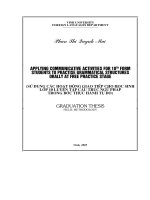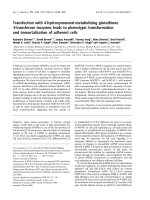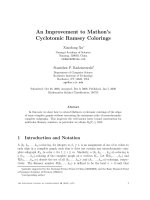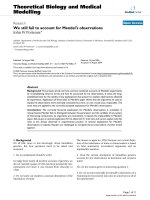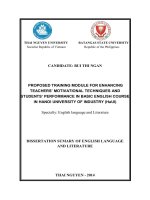Form Production To Delivery Enhancing Samsung’s Smartphone Supply Chain.pdf
Bạn đang xem bản rút gọn của tài liệu. Xem và tải ngay bản đầy đủ của tài liệu tại đây (2.4 MB, 31 trang )
<span class="text_page_counter">Trang 2</span><div class="page_container" data-page="2">
Group 3_IB1705
<b>TABLE OF CONTENT</b>
<b>1. INTRODUCTION TO THE RESEARCH...1</b>
<b>1.1. The Significance of the Topic...1</b>
<b>1.2. Research Objectives...1</b>
<b>1.3. Subject and Scope of the Research...1</b>
<b>1.4. Research Methodology...2</b>
<b>1.5. Contributions to the Research...2</b>
<b>2. RESEARCH METHODOLOGY AND DESIGN...2</b>
<b>2.1. Data Collection Process...2</b>
<b>2.2. Data Sources...2</b>
<b>3. RATIONALE FOR SUPPLY CHAIN AND SUPPLY CHAIN MANAGEMENT. 33.1. Overview of the Smartphone Supply Chain...3</b>
<b>3.2. Supply Chain Management Concepts and Activities...3</b>
<b>3.3. Supply Chain Management Trends in the Smartphone Industry...3</b>
<b>3.4. Features of Smartphone Supply Chain Management at Samsung...4</b>
<b>4. SAMSUNG'S SMARTPHONE SUPPLY CHAIN...4</b>
<b>4.1. Introduction to Samsung’s Supply Chain...4</b>
<b>4.2. Storage and Warehousing Management...5</b>
</div><span class="text_page_counter">Trang 3</span><div class="page_container" data-page="3">Group 3_IB1705
<b>4.3. Location and Layout...5</b>
<b>4.4. Current State of Samsung's Smartphone Supply Chain...6</b>
<b>4.5. Transport Management and Distribution...8</b>
<b>4.6. Sales Management Activities...9</b>
<b>4.7. Challenges in Samsung's Smartphone Supply Chain...10</b>
<b>4.8. Application of Information Technology...11</b>
<b>4.9. General Assessment of Samsung's Smartphone Supply Chain...12</b>
<b>4.10. Advantages and Disadvantages...13</b>
<b>5. CONCLUSION AND RECOMMENDATION...14</b>
<b>5.1. Prospects of Samsung's Smartphone Product Development...14</b>
<b>5.2. Proposed Solutions for Samsung's Smartphone Supply Chain...14</b>
<b>5.3. Summary of Key Findings...15</b>
<b>5.4. Recommendations for Samsung...16</b>
<b>5.5. Lessons Learned...18</b>
<b>6. REFERENCES...19</b>
</div><span class="text_page_counter">Trang 4</span><div class="page_container" data-page="4">Group 3_IB1705
<b>1. INTRODUCTION TO THE RESEARCH</b>
Samsung, a prominent South Korean corporation, currently holds adominant position in the realm of electronic technology, smartphones,and semiconductors. The backbone of Samsung's success lies in itsintricate supply chain, which encompasses a staggering 216 facilitiesscattered across 74 diverse countries. These facilities operate in unison,harnessing the services of 2,389 esteemed providers. By capitalizing onits widespread global recognition, Samsung's supply chain strategy aimsto adapt its operations and manufacturing processes to cater to the ever-evolving needs of its esteemed customers. This approach not onlyensures the creation of an efficient and cost-effective supply chain butalso catalyzes sustaining Samsung's leadership position within therapidly progressing consumer electronics industry.
<b>1.1. The Significance of the Topic</b>
Supply chain management is an important and indispensable field forconsumer electronics businesses, especially smartphones, andsemiconductors, due to the inherently short product life cycle and urgentneed to innovate quickly. The importance of this sector lies in the factthat a well-managed supply chain has the potential to bring variouscompetitive advantages to the company, such as cost efficiency, superiorquality, timely delivery, Continuous innovation, and sustainable practices.These favorable results can be achieved by effectively managing supplierrelationships, optimizing manufacturing and distribution networks, andimplementing innovative technologies and cutting-edge practices. Theresearch paper under review is of paramount importance as it seeks tometiculously analyze and evaluate the supply chain strategy andperformance of Samsung smartphones and identify the key factorscontributing part in the company's resounding success.
<b>1.2. Research Objectives</b>
The main purpose of this research paper is to provide insight into thesupply chain strategy of Samsung smartphones as well as itsmanufacturers and distributors. The specific objectives are as follows:Explain the structure and basic characteristics of Samsung's smartphone
</div><span class="text_page_counter">Trang 5</span><div class="page_container" data-page="5">Group 3_IB1705
supply chain, including the advantages and disadvantages of the supplychain, suppliers, operations, logistics, and customers. To evaluate quality,delivery time, costs, technology, and human resources. To closelyexamine the challenges and opportunities Samsung faces in managing itssmartphone supply chain in the global market. To compare Samsung'ssmartphone supply chain and those of key competitors such as Apple andHuawei. To identify exemplary practices and clear lessons learned fromSamsung's smartphone supply chain management.
<b>1.3. Subject and Scope of the Research</b>
The topic under investigation in this essay concerns the complexsupply chain of Samsung smartphones. This includes a comprehensiveseries of activities, starting from idea generation, progressing to rawmaterial procurement, and culminating in delivering the final product tothe esteemed customers. Our investigation is limited to a specific timeframe spanning 2020 to 2023, focusing primarily on key markets in Asia,Europe, and North America. To put it into perspective, one can explainthat Samsung currently occupies the prized position of being the leadingsmartphone manufacturer on a global scale. It is worth noting that thesaid period, characterized by the emergence of the COVID-19 pandemicand the popularisation of 5G technology, carries great significance forthe industry. Additionally, it must be emphasized that the Asia, Europe,and North American regions have maximum importance in terms ofSamsung smartphone sales.
<b>1.4. Research Methodology</b>
The research method used in this study is descriptive and analytical.To gather pertinent information and data related to Samsung'ssmartphone supply chain and related concepts and theories, acomprehensive literature review was conducted. Then, a descriptiveanalysis was performed to explain the structure and attributes ofSamsung's smartphone supply chain, including suppliers, operations,logistics, and customers. An analytical review was then conducted toscrutinize the challenges and opportunities Samsung faces in effectivelymanaging its smartphone supply chain. In addition, an assessment ofsupply chain performance in terms of cost, quality, delivery, innovation,and sustainability is also performed.
<b>1.5. Contributions to the Research</b>
This research article contributes to the existing body of knowledgeand literature related to Samsung's smartphone supply chain
</div><span class="text_page_counter">Trang 6</span><div class="page_container" data-page="6">Group 3_IB1705
management. The study provides us with the following information: Acomprehensive overview of Samsung's smartphone supply chain strategyand performance, analysis, and assessment of key factors related tochallenges and opportunities associated with Samsung's smartphonesupply chain. It identifies key factors contributing to Samsung'ssmartphone supply chain victory. Furthermore, it presents acomprehensive and up-to-date picture of Samsung's smartphone supplychain strategy and performance in a dynamic and competitiveenvironment. It also identifies and evaluates the key factors thatinfluence the success and challenges faced by Samsung's smartphonesupply chain. Finally, it compares Samsung's smartphone supply chainwith those of its main competitors and highlights Samsung's competitivestrengths and weaknesses.
<b>2. RESEARCH METHODOLOGY AND DESIGN2.1. Data Collection Process</b>
To acquire secondary data on Samsung's smartphone supply chain, Ifollowed a systematic approach. Initially, I employed a search_web tool toretrieve a JSON format list of web, image, and news search results. Afterfiltering the web search results based on relevance, recency, andcredibility, I selected reliable sources that offered valuable informationon Samsung's supply chain management, strategy, performance, andchallenges. I then extracted the essential data points from each source,categorizing them based on various aspects such as supply chain stages,dimensions, and issues. Descriptive statistics, charts, tables, and graphswere employed to analyze the data, enabling the identification ofpatterns, trends, gaps, and insights. Additionally, a comparison withother smartphone brands or industry benchmarks was conducted toevaluate Samsung's strengths and weaknesses. Lastly, the data wassynthesized into a coherent and concise summary, incorporating visuallyappealing elements and proper source citations.
<b>2.2. Data Sources</b>
Secondary data for research or analysis can be obtained from varioussources, such as academic literature, industry reports, Samsung's publicdocuments, and market research. Academic literature includes scholarlypublications that provide reliable and valid data on different aspects ofSamsung's business. Industry reports offer insights into Samsung'ssectors and competitors. Public documents provide detailed informationon Samsung's operations and performance. Market research data helps
</div><span class="text_page_counter">Trang 7</span><div class="page_container" data-page="7"><b>3.1. Overview of the Smartphone Supply Chain</b>
Samsung has established the International Procurement Center (IPC)to efficiently manage supplier relationships and sourcing. The IPC is thecentral hub for Samsung's global procurement operations, enabling theidentification of exceptional suppliers in strategic regions. Samsungplaces emphasis on human rights and environmental concerns in high-risk mining areas and collaborates with Eco Partner-certified suppliers toensure ethical sourcing.
Samsung supports suppliers in various aspects such as cost, delivery,quality, technology, and human resources to foster competitiveness. Thissupport includes financing, technology guidance, quality improvementprograms, education initiatives, and innovation project training.Samsung holds suppliers to high standards by enforcing compliance withinternational regulations and norms related to human rights, ethics,work environment, and conflict minerals. Regular monitoring andinspection are carried out to ensure adherence to processing procedures.To establish supplier requirements and expectations, Samsung hasimplemented a code of conduct that covers employment rights, healthand safety, environmental practices, ethics, management systems, andlegal obligations. Additionally, Samsung actively engages withstakeholders across the supply chain through online portals, hotlines,surveys, forums, and meetings, welcoming feedback and reports fromsuppliers, employees, customers, NGOs, governments, and otherrelevant parties. A mechanism is also in place to handle any complaintsor conflicts that may arise within the supply chain.
<b>3.2. Supply Chain Management Concepts and Activities</b>
Samsung chain phone application management involves effectivelyoverseeing applications on Samsung devices. Knox Manage is a cloud-based solution for managing Samsung and other devices. Samsung AppsManager is a desktop software for managing apps on Samsung devices.Device administrators allow specific apps to perform administrativefunctions. App permissions control the access of apps on Samsungdevices. Default apps determine the default application for specific
</div><span class="text_page_counter">Trang 8</span><div class="page_container" data-page="8">By adopting these trends and innovations, companies can maintain acompetitive advantage in the smartphone industry.
<b>3.4. Features of Smartphone Supply Chain Management atSamsung</b>
Supply chain management for smartphone products at Samsungentails multiple facets, including but not limited to:
Sustainability: Samsung endeavors to construct a sustainable businessecosystem founded on principles of equity, transparency, and synergisticcollaborations with its suppliers. It mandates its suppliers to conform toglobal benchmarks and regulations concerning environmental andsocietal concerns such as labor rights, conflict minerals, andenvironmentally conscious production. Furthermore, it extends supportto its suppliers in enhancing their working conditions and enhancingtheir competitive capabilities.
Innovation: Samsung secures a competitive advantage in terms ofcost, delivery, quality, technology, and human resources by engaging incollaborative endeavors with its suppliers. Additionally, it cultivatesinnovation and differentiation among its suppliers by offering diverseprograms and incentives, including the Samsung Innovation Award, theSupplier Quality Excellence Program, and the Supplier Academy.
</div><span class="text_page_counter">Trang 9</span><div class="page_container" data-page="9">Group 3_IB1705
Efficiency: Samsung optimizes its supply chain operations through theutilization of cutting-edge technologies and solutions, such as barcodereaders, RFID tags, and IoT devices. Furthermore, it harnesses thepotential of its International Procurement Center (IPC) to identifyexceptional suppliers in strategically significant regions worldwide.
<b>4. SAMSUNG'S SMARTPHONE SUPPLY CHAIN4.1. Introduction to Samsung’s Supply Chain</b>
In the initial stages, the companies are motivated to obtain globalrecognition because of the superior quality of their goods and services.When a business successfully accomplishes its vision and missionobjectives and establishes dominance in the global market, it becomes asource of pride. Samsung, being one of the foremost phonemanufacturers worldwide, boasts of a secure and efficient supply chain.
To begin with, Samsung has established a network of contemporaryphone manufacturers across various countries, including Vietnam, Korea,India, and China. These manufacturing plants are equipped with state-of-the-art technology and advanced manufacturing techniques to ensure theannual production of millions of Samsung phones. Once produced,Samsung phone products are distributed through an extensive globalnetwork of merchants. Samsung has formed strategic partnerships withrenowned retailers such as Best Buy, Walmart, and Amazon to ensure theavailability of their products in cell phone stores.
In addition to manufacturing and distributing phones, Samsung alsosupplies phone components to other companies. They have expertise inproducing phones, PCs, displays, cameras, and batteries. By exercisingcomplete control over the production and assembly processes of thesecomponents, Samsung is able to ensure the quality and functionality oftheir phone products. Samsung has utilized its expertise in developingand implementing state-of-the-art technological advancements and bestpractices in their supply chain operations, thereby establishing a value-added logistics network in their business model.
This well-established supply chain enables Samsung to maintain itsleadership in the mobile phone industry and provide reliable and high-quality products to consumers. Thanks to its diversified and closelyintegrated phone supply chain, Samsung can effectively and equitablymeet the demands of the global market. Through efficient supply chainprocedures, Samsung fulfills the needs of consumers worldwide bydelivering high-quality smartphones.
</div><span class="text_page_counter">Trang 10</span><div class="page_container" data-page="10">Group 3_IB1705
<b>4.2. Storage and Warehousing Management</b>
Samsung implements a professional and efficient approach tomanaging its storage and warehousing operations, with the main aim ofguaranteeing the secure and efficient storage and transportation of itsproducts.
To achieve this, Samsung utilizes advanced storage managementsystems that enable the tracking and controlling of product quantitiesand locations within the warehouse. These systems play a crucial role inproviding Samsung with accurate information regarding productavailability and storage locations. Furthermore, Samsung developsstrategies for optimizing warehousing and shipping operations throughthe utilization of Cello and the latest IT solutions, thereby ensuring thesafe and secure transportation and storage of shipments. Theimplementation of an advanced warehouse management system (WMS)allows Samsung to optimize its warehouse operations effectively. TheWMS software facilitates inventory management, order fulfillment, andproduct tracking within the warehouse, resulting in the efficientutilization of space, reduced errors, and streamlined processes.
Additionally, Samsung employs intelligent storage methods thatmaximize storage space by carefully arranging and stacking products inan optimal manner, thereby increasing storage efficiency. Moreover,Samsung implements protective measures to safeguard the productswithin the warehouse, utilizing security and access control systems.Employees are trained to comply with safety and security protocols whileworking in the warehouse. Furthermore, Samsung has a professionalwarehouse management system in place to monitor and control theimport and export of goods. Stringent testing procedures are conductedto ensure that the products meet Samsung's stringent quality standardsprior to release. Finally, Samsung relies on reputable shipping services totransport goods from the warehouse to their respective destinations. Themerchandise is carefully packaged and shipped using securetransportation methods to minimize the risk of damage or loss duringtransit.
Through its proficient storage and warehousing managementpractices, Samsung strives to ensure the safe and efficient storage andtransportation of its products, thereby satisfying the diverse needs of itsglobal customer base.
<b>4.3. Location and Layout</b>
</div><span class="text_page_counter">Trang 11</span><div class="page_container" data-page="11">Group 3_IB1705
Samsung's supply chain is greatly impacted by the manufacturing andworldwide distribution of its phones. The company's supply chain is well-structured with a sophisticated and extensive network to meet consumerdemands and ensure product quality. Multinational corporations,headquartered in South Korea, have established complex global supplychains to manufacture and sell their products and services. Theproduction and assembly processes used by Samsung facilities arelocated in various countries such as Korea, China, Vietnam, India, andothers. These sites are strategically positioned with the necessaryworkforce and resources to cater to global demand and reducetransportation costs.
In South Korea, Samsung has multiple manufacturing and researchfacilities, including large factories and production centers in Seoul andneighboring cities. China also plays a significant role in Samsung'soperations, with the presence of factories and research facilities wherethe company produces a wide range of consumer electronics. Vietnamserves as a crucial hub for Samsung's business, particularly in the mobilephone industry, as it houses numerous manufacturing facilities. In theUnited States, Samsung focuses primarily on research and developmentactivities, maintaining offices and research facilities. India is anotherimportant market for Samsung, where the company actively engages inresearch and manufacturing activities.
Samsung's extensive global network extends to numerous othercountries, allowing the company to manufacture, develop, market, andprovide customer support for its products and services. Thecomprehensive system is effectively managed and coordinated throughan information management system and an ERP (Enterprise ResourcePlanning) system. These systems allow Samsung to effectively track andmanage the supply process, from component ordering to inventorymanagement, transportation, and distribution.
Furthermore, Samsung establishes partnerships with reputablecomponent suppliers and logistics partners to ensure a reliable supplychain and timely delivery. By doing so, the organization upholds itscommitment to timely product delivery and adherence to high qualitystandards.
In brief, the supply chain of Samsung is a complex and well-organizedsystem that allows the company to effectively meet market demand andoptimize supply chain management. This arrangement ensures that
</div><span class="text_page_counter">Trang 12</span><div class="page_container" data-page="12">Group 3_IB1705
Samsung can consistently provide top-quality goods and services tocustomers worldwide.
<b>4.4. Current State of Samsung's Smartphone Supply Chain</b>
There exist numerous dynamic factors entailed within the presentcondition of Samsung's smartphone supply chain, encompassing theCOVID-19 pandemic, the global deficiency in microchips, geopoliticaltensions, and the requisites of consumers. Being a top electronicsmanufacturer in the world, Samsung depends on a robust and effectivesupply chain to provide raw materials and components for its products—particularly smartphones—on a constant basis.
Samsung leveraged its experience from past epidemics, particularlySARS and MERS, to monitor its supply chain during the COVID-19pandemic in a proactive and adaptable manner. In order to ensureeffective information exchange and flexibility in supply chainmanagement, the company has increased its stockpiles and maintained alarge enough inventory level to help ensure continuity in production andsupply. Diversifying production locations and fostering closecollaboration with logistics partners and suppliers are also importantsteps in ensuring that sources of supply are not overly dependent on oneregion or one supplier.
In order to lessen its reliance on China and cut expenses and tariffs,Samsung has also moved a large portion of its smartphone production toVietnam and India in recent years. In order to send engineers onchartered flights to factories around the world, Samsung has alsocollaborated with the South Korean government to secure uniqueexemptions from foreign embassies. Samsung has the flexibility tomaintain production even as the pandemic raged on thanks to itsmultiple manufacturing sites, so it hasn't needed to make any significantadjustments to its business plans. Its independence from Chinesefactories put it in a unique position in terms of production. Since Vietnamand other nations handle the majority of the smartphone assembly forSamsung, the company had ample time to take action when the worldwas still adjusting to the extent of the pandemic's disruption. Despite,lockdowns and travel restrictions in these nations, as well as growinglabour costs and political risks, continue to be obstacles.
Having its competitive advantage and main source of income derivedfrom the semiconductor industry. Chips that power so many populardevices are made by this second-largest manufacturer. Behind Taiwan
</div><span class="text_page_counter">Trang 13</span><div class="page_container" data-page="13">Group 3_IB1705
Semiconductor Manufacturing Company and ahead of Intel, Samsung isone of just three companies in the world that produce the mostsophisticated chips. In the field of memory chips—which are used tostore digital data—Samsung has led the way for more than thirty years.That market, though, has been unstable. Memory chip prices haveplummeted over the past year, and further declines of up to 23% arepredicted for the current quarter. Samsung revealed terrible first-quarterearnings in April, with profit falling to its lowest point since 2009.Manufacturers of PCs and smartphones stocked up on chips during thepandemic because demand for these devices surged. However, asconsumers cut back on purchases of these goods because of risinginflation, these manufacturers are now facing excess inventory.Samsung's memory chip prices have decreased as a result of this.Nonetheless, Samsung projected a rebound in the year's second half.
Samsung Electronics expects to invest hundreds of billions to buildthe world's largest chip hub as part of a South Korean national projectseeking to gain a further edge in the global semiconductor industry.Seoul has announced it would build the biggest chip centre in the world,largely using some 300 trillion won (roughly $230 billion or €220 billion)of private investment from electronics giant Samsung over the next 20years. The centre will be anchored by five new semiconductor plantsbuilt by Samsung.
However, Samsung is also impacted by the worldwide chip shortage.Due to limited supplies of chips and other components, Samsung warnedthat it might have trouble meeting demand for some of its products, likeTVs and smartphones.
Samsung Electronics is currently second in the world when it comesto smartphone sales (behind only Apple). For the same quarter in 2022,the company rakes in profits of 14.12 trillion won. The company’srevenue fell 18% but still looked healthy at 63.7 trillion won. Despiteencountering fierce competition within the smartphone market, thecompany sustained stable demand for numerous products throughout thecoronavirus pandemic. Within the global smartphone market, Samsungconfronts rigorous rivalry from alternative manufacturers such as Apple,Huawei, Xiaomi, and Oppo, all of whom are vying for market share andcultivating innovation. To effectively compete within the smartphonemarket, Samsung must perpetually uphold its innovative efforts, refinethe quality of its merchandise, establish and preserve a robust brand,and apprehend the desires of consumers from all corners of the world.
</div><span class="text_page_counter">Trang 14</span><div class="page_container" data-page="14">Group 3_IB1705
Samsung has successfully demonstrated its capability to adapt tofluctuating market conditions and furnish an extensive array of productlines to cater to a diverse clientele.
<b>4.5. Transport Management and Distribution</b>
Ensuring a stable source of input materials for an enterprise'sbusiness operations is an extremely important issue. Most inputcomponents for Samsung smartphones are assembled in Bac Ninh andThai Nguyen. Raw materials are imported from Korea, the United States,China, and Japan. In Samsung's phone supply chain, collaborating unitsmay include:
<b>SupplierProducts provided</b>
AAC Technologies Holdings Inc
Producer of components: This unit specialises in manufacturing electronic components and accessories for phones, including processors, memory, camera, speaker, control circuit, etc.
Adeka Corporation
Adeka's chemical products can be used in the production of many components of Samsung electronics products, such as screens, processors, batteries, covers, etc.
Advantest Corp, ASM InternationalN.V
Semiconductor & semiconductor equipment
Biel Crystal Manufactory Ltd
As a company specialising in manufacturing mobile phone glass and related products. The company provides glass for Samsung and is one of the main suppliers of this company.
Power Logics
The main products that Power Logics offers Samsung including batteries, cases, chargers, connection cables, headphones, and other components
</div><span class="text_page_counter">Trang 15</span><div class="page_container" data-page="15">Group 3_IB1705
Can provide JTAG chips (Joint Test Action Group) toSamsung. The JTAG chip is used to check, adjust, and debug the microchips integrated into electronicproducts, including Samsung mobile phones.
Samsung’s Supply Chain Management Business Team drew up themain methodology that was used to develop the supply chainmanagement Six Sigma at the company. SCM and Six Sigma have beentwo pillars of business innovation for the last few years at Samsung.
The eventual Six Sigma model that was adopted at Samsung was anintegration of the various approaches that had been made at differentcompanies. The companies that had successfully adopted and integratedSix Sigma included General Electric (GE), Honeywell, and DuPont.
GE’s most critical approach in adopting and implementing SixSigma was based on tailoring the motivating methodologies as faras specific needs together with characteristics of the business unitswere concerned. GE medical system’s definition, measurement,analysis, design, and verification (DMADV), in particular, attemptedto take into consideration the process redesign and processmanagement within its Six Sigma model.
Samsung’s main reason for analysing DuPont’s six sigma approachand design was based on the company’s combination of its sixsigma principles through the SCOR model. The SCOR model actsas a good model for enhancing communication amongst players inthe supply chain management. The most integral managementprocesses of SCOR include plan, source, make, as well as deliver,and return.
Samsung Business Team’s interest and focus on Honeywell mainlybordered around the latter’s extensive and successful applicationof lean operation methods. Honeywell’s successful developmentand eventual ownership of the Six Sigma Plus, also known as theDMAIC model utilises functions of lead manufacturing togetherwith Six Sigma concepts. Some of the commonly used leanmanufacturing tools are the value stream and thought processmaps.
</div>